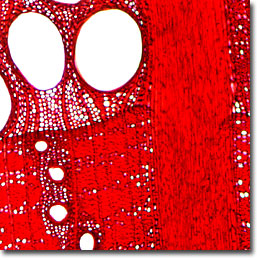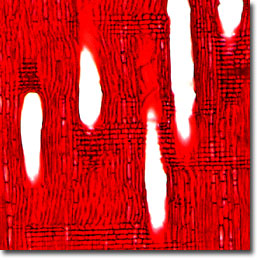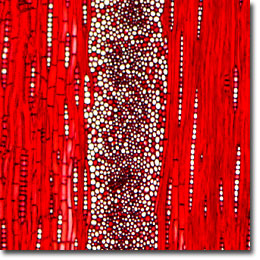The Northern Red Oak
The Northern Red Oak (Quercus rubra) is a broadleaf hardwood tree primarily found in the eastern United States except in the coastal areas. This tree grows to heights of 80 feet and has a broad and rounded top. The trunk diameter measures up to 10 feet and the bark is almost black in color, but the sapwood is white to gray or pale reddish brown. In contrast, the heartwood is pink to light reddish brown (occasionally light brown), often with a flesh-color cast.

Cross Section

Radial Section

Tangential Section
A tall, relatively fast-growing tree, the red oak shape is conical when young and becomes more rounded as the tree reaches maturity. The shiny green leaves, which are oblong and up to nine inches long with bristle-tipped lobes, often turn deep to bright red in the fall. The red oak is one of the easiest trees to transplant and is a useful shade tree, except in regions affected by the oak wilt disease.
The northern red oak tree is propagated by seed and prefers a rich soil, but will grow in most average soils. Indians often included red oak acorns in their diets. They removed the natural acids from the acorns by grinding and washing them in hot water. Northern red oak wood is used for flooring, mill products (sash, doors, trim, wainscoting, general millwork), furniture, kitchen cabinets, fixtures, railroad cars, boxes, crates, and pallets. Other uses include skids, ships and boats, agricultural tools, caskets and coffins, and tool handles.
Microscopic examination of iron-alum hematoxylin and safranin stained thin sections (see the digital images presented above) reveals very few vessels in late wood and simple perforation plates. The pits leading to contiguous trachea cells average 6 to 10 micrometers in diameter and are orbicular to oval in shape. Vasicentric tracheids are present and intermingled with the abundant parenchyma. Libriform and tracheid fibers are medium to thick, frequently gelatinous, and fine to medium in texture. The rays are unstoried, homocellular and 12 to 30 seriate.